Difference Between 12 Bar Blues and 32 Bar Blues
In this lesson, we are going to look at the 12-bar blues, which is a popular chord progression used in countless songs. We will also explore the minor blues scale and look at how it's a perfect fit for the 12-bar blues chord progression.
What Is A 12 Bar Blues?
The 12 bar blues is one of the most popular chord progressions in all of music. It has been used to produce countless hits including outside of the blues genre. For guitarists, it is an essential part of our repertoire. So what is it? Well, it has 12 bars, but I'm guessing that you already figured that out by the title. Before we look at exactly what it is, we need to be familiar with I, IV and V chords.
1, 4 and 5 (I, IV and V) Chords
To be able to play a blues, we need three chords – 1, 4 and 5. In the previous lesson on song writing and chord theory, we learnt that each key is made up of seven chords, one for every note of the major scale. We also learnt that chords are often written by using roman numerals. If you read the previous lesson, this will all make sense. If not, you read it here.

7 Chords In A Key
Just to recap, the seven chords in a key are as follows:
- I – Major
- ii – minor
- iii – minor
- IV – Major
- V – Major
- vi – minor
- vii – diminished
The I, IV and V chords represent the Major chords in a given key (which is why the numerals are written in uppercase).
Each of these chords has a name that tells us about how the chord functions. I is the Tonic, IV is the Subdominant and V is the Dominant. The other chords have labels too, but we're not concerned with them at the moment. In fact, the labels aren't even that important for now. It's probably easier to just refer to them as I, IV and V. I have mentioned the labels because it's good to be thorough, but also, it's an insight into the fact that each chord has a relationship to the other chords, or a function. These functions are probably more abstract than they are concrete, but just being aware that they exist can help you to understand chords better. Although it is difficult to articulate the function of each chord, it helps to give a general idea. Here it goes.
The I Chord
The 'I' Chord is like the 'home' chord in any key. If we are playing a song in the key of G major, the G major chord is the I chord. It will always feel comfortable and safe. When we reach this chord after playing another chord, it feels like we have arrived back home. All is well again.
The IV Chord
The 'IV' Chord is another safe chord that always seems to work well. Although it is 'safe' and 'comfortable', it creates a little bit of tension, because it is a move away from the 'I' chord. This is a good example of how chords have relationships.
The V Chord
The 'V' Chord is bold and daring. While it usually sounds good, bright and interesting, it does create tension. It's a tension that wants to be resolved back to the I chord. This is another example of thinking of chords with relationships in mind – a G Major chord in the key of C is the V chord. It has a different feeling when played in the key of C than it does when played in the key of D (it becomes the IV chord). If we were to play a G major chord in the middle of a song that is in the key of B, it would sound weird, because G major does not belong in the key of B. The point is this – the sound of a chord is really dependent on context.
The above 'descriptions' of the I, IV and V chords are deliberately vague. They sound more like an opinion than a technical analysis. But that's the point. Rather than getting overly technical when describing the function of chords, the best approach is to try to experience them yourself and try to articulate what effect they have.
The Importance Of I, IV And V
As I mentioned earlier, the I, IV and V are the 'strongest' three chords in a key. There are many many songs that only use these three chords. Some only use two (such as the I and IV, or I and V). These three chords work together so well, that it's very easy to write songs using just the I, IV and V. You should experiment with playing I, IV and V in any key and observe how well they fit together. Move freely from one chord to the other. You will probably be reminded of specific songs as you play the chords, because they are so common.
Constructing The 12 Bar Blues
The 12 bar blues is made up of 12 bars (crazy, huh?) and yep… you guessed it.. the I, IV and V chords. Although there are many variations, the basic 12 bar blues follows a particular pattern of the three chords. It goes like this:
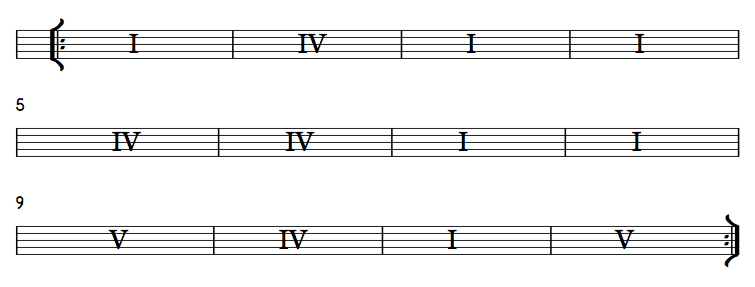
Playing the 12 Bar Blues in a particular key is simply a matter of figuring out the I, IV and V of that key and then using those chords with the above form. Let's do an example. The key of Bb has the following chords for I, IV and V:
- I = Bb
- IV = Eb
- V = F
The 12 bar blues in the key of B flat would look like this:
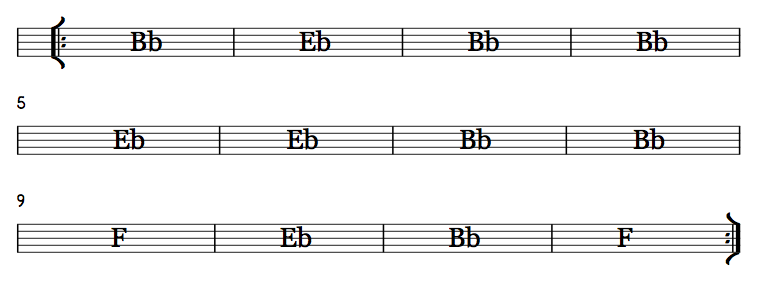
Simple right? You can do this with any key. You should practise playing this chord progression in different keys, just to get used to the process and become familiar with the chord progression. You will probably feel a sense of familiarity when you play/hear the chord progression as you would have heard it in various formats many times before.
Adding Dominant 7 Chords
While the above 'formula' is the basic 12 Bar Blues, often we turn each chord into a 'Dominant 7th' chord. The dominant 7th chord is the name that we give to chords that we shorten to '7'. For example, 'A7' is actually an 'A Dominant 7th' chord. 'B flat 7' is actually a 'B Flat Dominant 7th chord'. And so on. In the lesson on arpeggios, we explored the notes that make up different chords. If you're interested, the notes in the dominant 7th chord are:
- 1 – 3 – 5 – b7

You can read more about the Dominant 7th Chord/Arpeggios here. Turning each chord into a 7th chord would make the slightly modified formula look like this:
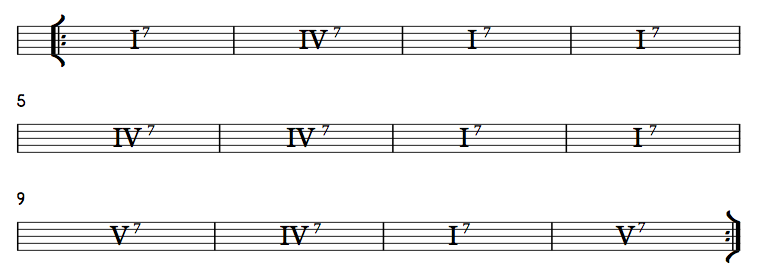
If we were to play a 'D Blues' using 7th chords, it would look like this:
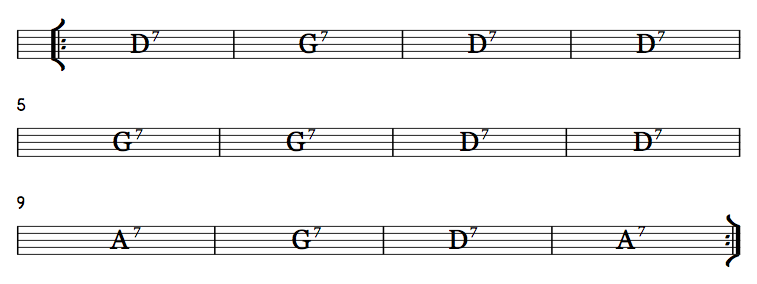
Variations:
The 12 Bar Blues is a pretty simple chord progression. It sounds familiar. We're used to it and it always works well. The power of the 12 Bar Blues however, is in the potential to use it as a starting point. In the above examples, each chord was played with a very simple strumming pattern, without altering the chords or the rhythm. It sounded good, but perhaps a little bland. The reason why the chord progression can be used in thousands of different songs, without it sounding like the same song is just being rehashed over and over again, is because of the potential to embellish the chords, rhythms, melodies and pretty much every other musical element you can think of.
What we're going to do now is play a 12 Bar Blues in the key of A, but instead of simply playing chords, we're going to use a riff. Each time there is a chord change, the riff will transpose to fit over the new chord. Here it is:
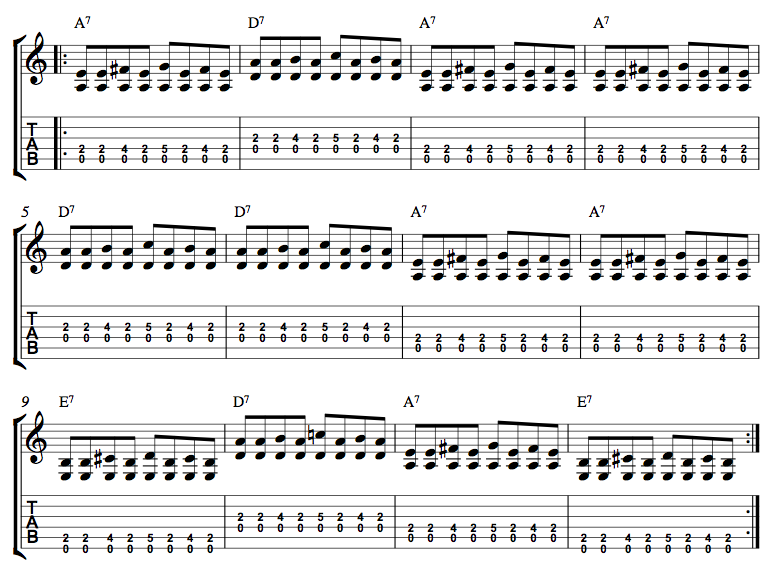
Even though we're not playing standard chords, you should be able to hear the sound of the chord changes through the riff. Here is another example:
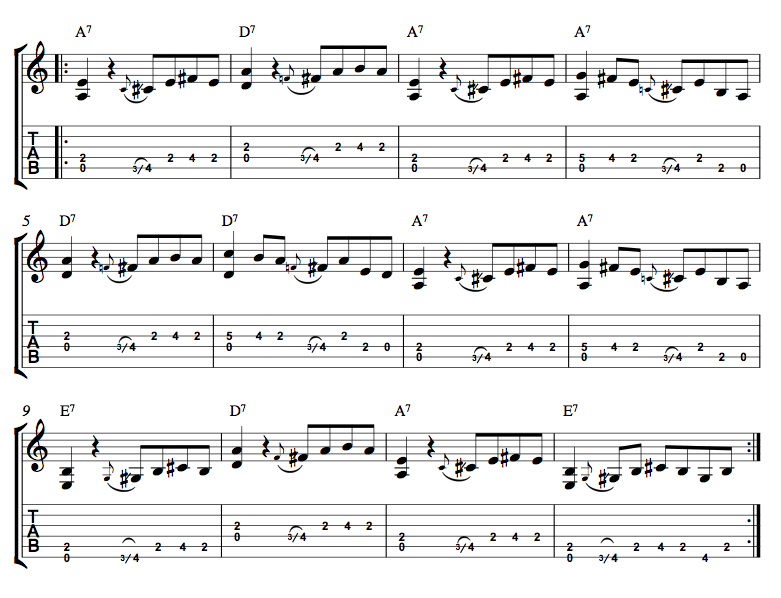
Again, we have still used the same chord progression, but played a different riff instead of standard chords, effectively creating a new song. In both of those examples, I have finished with an A7 chord at the end. The possibilities are endless – we could change keys, tempo, feel, time signature, and more. And all of this is without getting into melodies or additional parts.
The Minor Blues Scale
In the lessons on pentatonic scales, we learnt how to play the minor pentatonic scale, how to practise it in five different positions and how to improvise with it by learning licks. The minor pentatonic scale can be used over a 12-Bar Blues. When playing a blues in A, like in the above examples, we can use an A minor pentatonic scale to improvise and construct solos. There is however, another scale that is very similar, but much more bluesy. It is the minor blues scale. Here it is:

The notes that make up the minor blues scale are:
- 1 – b3 – 4 – b5 – b7
If we were to play an A minor blues scale over two octaves, starting on the 5th fret, it would look like this:

The 'Blue' Note
The thing that gives the minor blues scale its distinctive, bluesy sound, is what's known as the 'blue' note. It is the 'b5' note that just sounds bluesy and cool. The minor blues scale is really just a minor pentatonic scale, with the blue note added in. Observe the following two scale diagrams. The first diagram (to the left) is that of a minor pentatonic scale. The second diagram (to the right) is of a minor blues scale. Compare the two and observe how there are only two notes added to the pentatonic scale to produce the blues scale (actually there is only really one note added, but it occurs twice because the following diagrams cover two octaves). The 'blue' note (the note that is added to produce the blues scale) is filled in blue, to make it obvious:
You should be able to see (and hear, by playing) how similar they are, but also by comparing the two, you should notice the effect that the blue note creates. It adds a soulful, bluesy sound that has been the 'go to' sound for thousands of guitarists over many years. Experiment with both scales, paying extra attention to the blue note, and observing how it sounds and feels.
3 Blues Licks
What we're going to do now is look at three blues licks, using the minor blues scale. This is similar to what we did in the lesson on licks using the minor pentatonic scale. We're only going to use one position and we're only going to learn three licks. If you missed the lesson on the process of learning scales in five positions, and using licks to master scales and improvisation, read up on them by following the links. Here is the first minor blues lick.

Blues And Bending
Stylistically, bending notes and blues playing go hand in hand. Bending notes is a very expressive articulation, and it's almost impossible to hear a blues guitarist play without hearing a good amount of bends. If you remember from the lesson on advanced techniques, we learnt that bending a note increases the pitch of the note. Basically, we can use a bend to get from one note to another. While technically we can bend any note, there is one note that we bend often with the minor blues scale.

Let's take a look at the minor blues scale in terms of its properties:
- 1 – b3 – 4 – b5 – 5 – b7
The '4', '5' and 'b5' are all one semitone apart. This makes the '4' of the scale a very good note to bend. Why? Because as it is bent, the pitch increases. If we use a half bend, it becomes the 'b5'. If we keep bending it into a full bend, it becomes the '5'. Basically, the '4' of the scale is a great one to bend because as you bend it, you are effectively just playing other notes of the minor blues scale.
In the case of the A minor blues scale, the '4' is the D note. As we bend it, it moves towards Eb (the 'b5') and then towards E (the '5'). Experiment again with playing the minor blues scale and use bends, particularly with the '4'. Bends sound best on the 1st, 2nd and 3rd strings of the guitar, so you should spend more time experimenting with bends on those three strings.
Ok, back to the licks. We're going to look at two more blues licks. These ones have bends in them.


Blues Study
Now that you're familiar with the 12 Bar Blues and the minor blues scale, we're going to finish with a study that is based on both. Have a look, have a listen, then have a learn and enjoy!
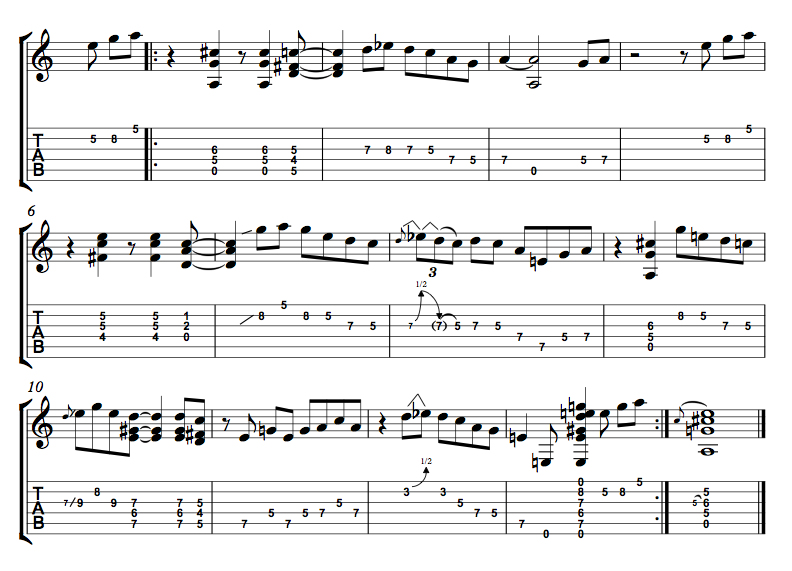
The 12 Bar Blues in Different Keys
Here are links to chord charts for the 12 Bar Blues in individual keys.
- 12 Bar Blues in Eb

Source: https://onlineguitarbooks.com/12-bar-blues/
0 Response to "Difference Between 12 Bar Blues and 32 Bar Blues"
Post a Comment